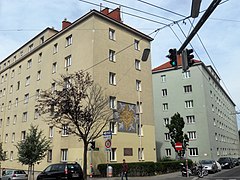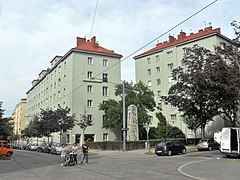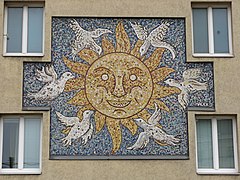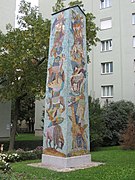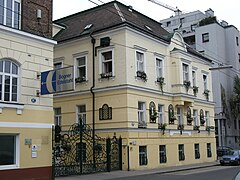Davidgasse
| Davidgasse | |
|---|---|
| Street in Vienna | |
| Basic data | |
| place | Vienna |
| District | Favoriten (10th district) |
| Created | 1875 |
| Cross streets | Leibnizgasse, Senefeldergasse, Columbusgasse, Muhrengasse, Laxenburger Straße , Siccardsburggasse, Leebgasse , van der Null Gasse, Alxingergasse , Herzgasse, Neilreichgasse , Karmarschgasse, Fernkorngasse, Sonnleithnergasse, Bernhardtstalgasse, Malborghetgasse, cast tie road , Braunspergengasse, to the spinner, Knöllgasse, Triesterstraße |
| Places | Reumannplatz , Arthaberplatz , Belgradplatz |
| use | |
| User groups | Pedestrians , bicycle traffic , car traffic , bus routes 7A 65A 66A |
| Road design | one way street |
| Technical specifications | |
| Street length | approx. 1644 m |
The Davidgasse is a long lane in the 10th Vienna district, favorites .
course
At the foot of the Wienerberg, Davidgasse connects the major arterial and long-distance roads of the 10th district in Vienna with its east-west course. Starting from Reumannplatz , it crosses Laxenburger Straße and finally ends at Triester Straße . In its course are the Arthaberplatz and Park, where it is interrupted, as well as Belgradeplatz with the Barankapark-Hellerwiese. There are around 100 house numbers on Davidgasse. The bus line 7A Wiener Linien runs over large stretches of Davidgasse and has several stops here. A short distance to the east there are also bus routes 65A and 66A. Almost the entire Davidgasse, from Reumannplatz to Gussriegelstrasse , is a one-way street .
history
On July 13, 1875, Davidgasse was named by the municipality of Inzersdorf after the magistrate's accountant Johann David, who was born around 1795 in Silesia and died on December 13, 1869 in Vienna. In this area, the so-called Ried Obergeiselsberg, he owned large properties, which he parceled out on March 28, 1862 and made available to the general public for the creation of Laxenburger Strasse and Simmeringer Weg. On July 5, 1894, Rittingergasse was incorporated into Davidgasse.
Between Reumannplatz and Laxenburger Straße, Davidgasse was densely built up with apartment buildings until the beginning of the 20th century, while the longer section between Laxenburger Straße and Triester Straße remained largely free and was then populated with individual factory buildings. Only since the 1950s has the street been continuously built with residential houses.
Remarkable buildings on Davidgasse
No. 6: Apartment building
Davidgasse 6 is an example of an apartment building from the beginning of the 20th century with secessionist architectural decorations. The architect was Hans Fenz .
No. 35: House with mosaic
The corner house facing Van-der-Nüll-Gasse 54 has a large mosaic on the side facing Davidgasse showing the architect Eduard van der Nüll .
No. 62–64: residential building
Davidgasse 62–64 is a semi-detached block that was built in 1913/14 according to plans by the architect Rudolf Otto Gerger . It has crested gables and relief decoration.
No. 78: Anna-Boschek-Hof
Between the Malborghetgasse and the Gußriegelstrasse is a large urban residential complex , which was built in the years 1953–56 on a vacant lot. The architects Harald Bauer, Josef Bayer, Siegfried Mörth, Rudolf Karl Peschel, Ferdinand Riedl and Fritz Slama were involved in the planning. The complex, which consists of several six-storey building blocks, comprises 415 apartments. There are green spaces between the houses. In 2009 the community building was named after the social democratic trade unionist and politician Anna Boschek . At the front of Davidgasse there is a mosaic sun , which was created in 1958 by Reinhold Hauck.
No. 85–87 and 89: former Reiss paper mill
Davidgasse 85–87 is the former Reiss paper mill, which was built here in 1908. On an L-shaped floor plan, a five-story, cubic post structure with long fronts arranged with pilaster strips rises . The ground floor is plastered while the rest of the building was built using exposed brick. Next to it at number 89 is the associated former residential building. It is three-story, has a central bay window and beautiful decorative grilles on the windows and between the buildings. During National Socialism until the liberation in 1945, the building / factory housed two camps for Hungarian Jews who were used for forced labor .
No. 92: former Abadie cigarette factory
This building, which is now largely used by the bfi vocational training institute , was built in 1910 for the former Abadie cigarette paper factory. The longer front of the building is located on the street Zur Spinnerin and is designed in exposed brick construction with additional plaster structure. Partly it has iron lattice windows.
The Abadie company was founded in Paris in 1783 and produced the first cigarette paper there. Since 1910 there was a branch in Vienna as well as in Prague. Before the First World War, around 1,000 workers were employed here. The Abadie company had been a joint stock company since 1923 and enjoyed great popularity during the First Republic because colorful picture cards were attached to its products. In 1938 Abadie was "Aryanized" and in 1955 came into the possession of Hans Behr, who merged the company with the competitor Altesse as Altesse Hans Behr & Co., before it was finally taken over in 1972 by Austria Tabakwerke .
literature
- Felix Czeike (Ed.): Davidgasse. In: Historisches Lexikon Wien . Volume 1, Kremayr & Scheriau, Vienna 1992, ISBN 3-218-00543-4 , p. 620 ( digitized version ).
- Dehio Handbook Vienna. X. to XIX. and XXI. to XXIII. District . Anton Schroll, Vienna 1996
Individual evidence
- ↑ Hans Fenz. In: Architects Lexicon Vienna 1770–1945. Published by the Architekturzentrum Wien . Vienna 2007. Retrieved on May 25, 2017.
- ^ Herbert Exenberger : Antifascist City Guide . Edited by the educational committee of the SPÖ-Vienna, Verlag Vorwärts, Vienna 1985, p. 79.
Web links
Coordinates: 48 ° 10 ′ 23.8 " N , 16 ° 22 ′ 29.1" E



